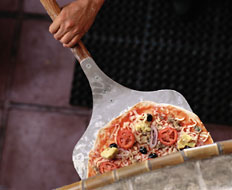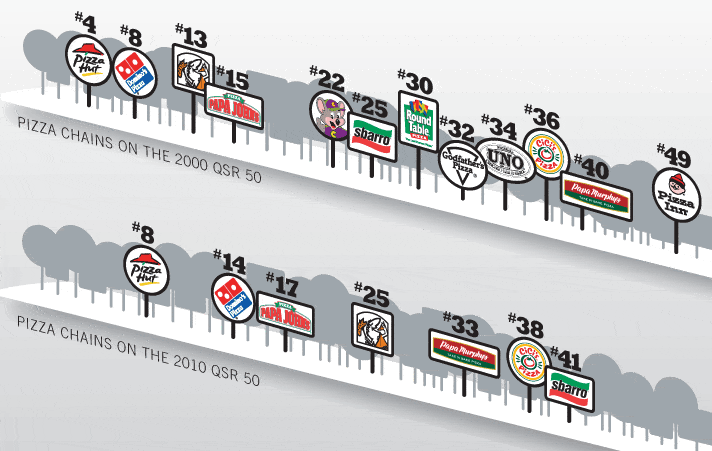What’s happened to pizza’s major players?
In 2000, the QSR 50 Report, this magazine’s annual ranking of the nation’s top quick-service brands, showed a robust American appetite for pizza, a category trailing only burger joints in representation. With pizza chains claiming four of the list’s top 15 slots and 12 of the top 50, the segment seemed poised to maintain its spot as a 21st century quick-service staple.
Over this century’s first decade, however, pizza’s momentum slowed—first to a jog, then to a crawl, and, for a time, some observers contend, even into reverse gear. In the most recent QSR 50, pizza chains held only four of the top 25 spots and seven of the top 50, with no fresh-blooded pizza chains even threatening to crack the list. More telling, the chicken category supplanted pizza as the runner-up to burgers in representation.
While the pizza category is far from extinction or irrelevancy, the segment’s decade-long decline paired with the acceleration of other quick-service categories (Mexican, sandwiches, and snacks, to name a few) threatens pizza’s standing as a quick-service heavyweight. It also doesn’t bode well for its future prospects, which challenge the segment’s major players to consider bold, even risky decisions to keep pace with a fast-evolving industry.
As last century closed, many of the nation’s largest pizza chains seemed poised for growth despite rising commodity costs and the segment’s heated rivalries. Yet as the 2000s unraveled, pizza’s major players traded marketing, menu, and price-warring jabs, a persistent clash that failed to produce any clear winner in a segment some call the restaurant industry’s most competitive.
Lucky number 13 on the QSR 50 report in 2000, Little Caesars dropped 1,000 outlets and $600 million in sales over the last decade. Chuck E. Cheese’s, once a top 25 player, has fallen into the background of other “eatertainment” options. Described as a “dynamo” in the 2000 QSR 50 with AUV approaching $1.9 million, Pizzeria Uno watched its parent company, Uno Chicago Grill, file for Chapter 11 bankruptcy protection in January 2010. Sbarro remained relatively stagnant, a product of ownership changes and declining mall traffic, while larger regional operations such as Pizza Inn, a one-time QSR 50 member, face consistent challenges from deeper-pocketed national brands and local independents.
Segment champion Pizza Hut claims 500 fewer units today and flat sales. In 2009, the Yum! Brands entity watched its sales fall 9 percent despite a new ad agency, upgraded online ordering, and a flashy $10 pizza promotion.
In 2006, CiCi’s Pizza, one of the category’s biggest up-and-comers and still a hard-charging player, projected it would crack the 1,000-unit barrier in 2010 with the addition of 400 new outlets. Four years and one recession later, CiCi’s store count remains in the mid-600s, a sign of just how much the recession slowed even those with promise, passion, and a plan.
Although some chains have bucked the trend—the always ambitious Papa John’s added more than 500 units and $700 million in sales over the last decade, while Papa Murphy’s Take ‘N’ Bake doubled both its unit count and sales since 1999—the 2000s remain a decade in which pizza’s major players largely lost industry standing.
One has to wonder: Was pizza’s fall due to increased competition? The low-carb craze? Management missteps? The general ebbs and flows of business? Or all of the above?
While the economy’s fallout stands as an easy excuse to rationalize pizza’s fall, the segment has historically withstood economic downturns by surviving as a family’s primary take-out item, which suggests that the crux of the segment’s slump exists elsewhere.
To be certain, consumers expanded their culinary horizons, and fast-casual outlets like Chipotle and Panera grabbed share over the last decade, which diluted some of the bigger pizza chains and created a modern quick-service landscape filled with shiny new places.
There were chains not on anybody’s radar a decade ago grabbing share … and greater competition for people’s money with less of it to go around,” Domino’s spokesman Tim McIntyre says.
Peter Saleh, a restaurant industry analyst with the Telsey Advisory Group, says many of the large pizza operations took their eyes off traffic in pursuit of higher check averages by raising menu prices and losing touch with the value equation so important to pizza consumers.
“There simply wasn’t as much focus on retaining customers and driving in new customers,” Saleh says. “Over time, this will come back to bite you.”
Toss in a compelling new age in retail offerings, including gourmet frozen pizzas and take-and-bake supermarket options, as well as a collection of more convenient meal solutions and even dietary fads, led by the no-carb craze, and pizza chains faced formidable, effective assaults on their supremacy.
“Marketing, product, and service all worked against the pizza category,” says NPD Group restaurant analyst Bonnie Riggs. “And overall, pizza got lax and lost ground.”
In some cases, complacency and questionable leadership decisions sparked a downward spiral. Consider Pizza Inn, which in the late 1990s began shedding its own locations, adversely impacting the brand and dropping store counts from 800 to about 300 today. The company’s debt load climbed, management troubles and litigation mounted, and franchisees expressed discontent and frustration.
“We lost our way as a company,” says Pizza Inn CEO Charlie Morrison, who’s been with the Texas-based company since 2007. “Opening a few stores and closing a lot is not a recipe for success.”
[pagebreak]
Above all, perhaps, many of the major brands struggled with an ill case of “the sameness,” dizzying consumers with similar products and promotions. The copycat syndrome led many brands to focus attention solely on pizza competitors, thereby neglecting a broader view of the entire quick-service category, its evolution, and changing consumer preferences.
“We know we’re competing with Papa John’s, Pizza Hut, and Little Caesars,” McIntyre says, “but sometimes we forget we’re competing with the likes of Chipotle and Qdoba as well.”
Domino’s ignorance, McIntyre says, remained in place until 2008 when, amid declining store traffic and a faltering economy, Domino’s executive team faced two choices for a company that turned public just four years before: woe is me or innovative, intrepid action.
“For 48 years, we were doing the same thing with a slight tweak here or there, and something had to give,” McIntyre says.
Eighty percent of Domino’s menu options weren’t around in 2008, with new items including pastas, oven-baked sandwiches, and gourmet pizzas.
“That’s created fresh opportunities, particularly with lunchtime consumers and those looking for something different,” McIntyre says.
Along with Domino’s, other competitors are taking a proactive approach to their slowing segment. For a time, many industry insiders wondered if Little Caesars was on its way to a slow, painful death. Stores closed and sales lagged. Yet on the way to extinction, the now 51-year-old, Detroit-based pizzeria began reversing course. The numbers swung upward, and today the brand is reestablishing itself as an industry player with inventive franchising programs and determined, strategic new market expansion.
Both Little Caesars and Domino’s are enjoying a recent resurgence.
In early 2010, the latter unveiled a new pizza recipe, among the boldest moves a major restaurant chain has ever attempted, that reinvigorated the brand. Combined with innovative advertising and store-level execution, Domino’s recipe shift sparked double-digit sales growth at its outlets and spirited responses from competitors.
Since mid-2009, Saleh says, analysts have noticed an increased focus among the major pizza chains on retaining customers. The new strategy is often the simplified promotion, such as Pizza Hut’s $10 any size, any crust, any toppings offer, as a way to generate traffic and hit on the value proposition.
“In this way, consumers know what they’re getting,” Saleh says, reminding that such aggressive promotions lean on the cooperation of commodity markets and franchisees.
The segment’s struggles also steered concept leaders toward menu development to drive traffic, a trend likely to accelerate in the coming years to fend off still-mounting challenges from retail and to advance recent gains with the lunch crowd.
For now, at least, pizza’s moves appear to be working.
Among the major quick-service chains, pizza’s on the uptick, according to NPD Group numbers. After seeing traffic decline 7 percent and 4 percent in the final two quarters of 2009, major pizza chains enjoyed a 6 percent traffic increase in 2010’s first quarter, just as marketing initiatives and incentives took shape. In the second and third quarters of 2010, major-pizza-chain traffic grew 4 percent and 5 percent, respectively. While the numbers enliven corporate executives, they just as importantly excite franchisees, the backbone of any system.
“When you wake up and take note of what’s around you, the competitive landscape can change in a hurry,” Riggs says. “That’s certainly the case with pizza and helps explain its most recent progress.”
With recent success fueling the segment, the question arises whether it can maintain its new pace.
NPD’s recent industry forecast shows only a marginal outlook for pizza, dampened prospects given an aging U.S. population, steep discounts that establish a “new normal” on pricing, and pizza’s sluggish performance over the last decade.
“But forecasts aren’t set in stone,” Riggs says, “and the outcomes can shift.”
[pagebreak]
According to industry analysts, pizza must continue hitting on value and convenience, two marketing mainstays. By and large, the segment remains a terrific value, offering the ability to feed a lot of people for not a lot of money. Furthermore, it remains a celebratory product; few people are upset when pizza’s laid on the dinner table.
“Ultimately, people eat pizza because it’s convenient and a good value, but I do fear that rising pizza prices could prompt consumer movement to other convenient dining options,” Saleh says. “Pizza has a real balancing act to pull off here.”
The category’s major players must respond to the restaurant industry’s wider evolution—hitting on convenience, value, flexibility, and quality in food as well as environment.
Pizza Inn, for instance, focused its efforts on new prototype stores launched at the end of 2008. The 4,000-square-foot, strip-center restaurants feature a 12-pizza buffet, salad bar, 150–180 seats, delivery, carryout, and red-and-white tabletops, an accommodating, fresh environment that resonates with a larger consumer base. The company also instituted initiatives to help franchisees succeed, including short-term royalty relief and a strategic companywide vision that includes a swelling focus on social media. Early returns show positive momentum: In fiscal year 2010, Pizza Inn opened more stores than it closed for the first time in 11 years.
“We’ve reinvented the concept and we’re growing again,” Morrison says.
For additional optimism as well as a plan of action, pizza may look no further than the burger segment, another staple of the American quick-service landscape.
A seemingly tired item, the burger has been resurrected by chains such as Five Guys and Smashburger, two concepts that surpassed traditional quick-service offerings and kicked competitors into innovation overdrive. The new concepts, fresh menu offerings, and line extensions appeal to recession-era diners who are trading down from fast casual, yet unwilling to skimp on quality. With the emerging wood-fired pizza craze, specialty pizzas with high-quality, gourmet ingredients, and advances in cooking technology allowing for pizza to be an individual occasion, the segment could have its own opportunity to rebound and follow burger’s lead, Saleh says.
And much like its burger brethren, some pizza chains will likely investigate a barbell pricing strategy wherein value items sit on one end of the menu and gourmet offerings on the other. Many will also pursue the upsell strategy, offering a $5 pizza as the hook and upgraded offerings or complementary products, such as appetizers or desserts, to raise the average ticket.
“The price competition over the last year has been unbelievable, but I’m not convinced it can continue down this road. We have to think about things differently—the dough, the toppings, the pricing,” Pizza Inn’s Morrison says. “We’re at the point where we all have to figure this out.”











